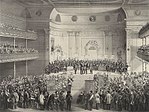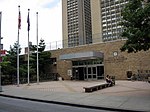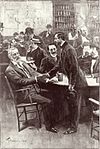Cable Building (New York City)
1894 establishments in New York (state)Beaux-Arts architecture in New York CityBroadway (Manhattan)Cable car railways in the United StatesCableways on the National Register of Historic Places ... and 8 more
Greenwich VillageMcKim, Mead & White buildingsNew York City Designated Landmarks in ManhattanOffice buildings completed in 1894Office buildings in ManhattanStanford White buildingsTransportation buildings and structures on the National Register of Historic Places in New York CityUse mdy dates from February 2020

The Cable Building is located at 611 Broadway at the northwest corner with Houston Street in NoHo and Greenwich Village, in Manhattan, New York City. Since it spans a block, the Cable Building also has addresses of 2-18 West Houston Street and 178-188 Mercer Street.
Excerpt from the Wikipedia article Cable Building (New York City) (License: CC BY-SA 3.0, Authors, Images).Cable Building (New York City)
Mercer Street, New York Manhattan
Geographical coordinates (GPS) Address Nearby Places Show on map
Geographical coordinates (GPS)
| Latitude | Longitude |
|---|---|
| N 40.725833333333 ° | E -73.996944444444 ° |
Address
Angelika cinema
Mercer Street
10012 New York, Manhattan
New York, United States
Open on Google Maps








